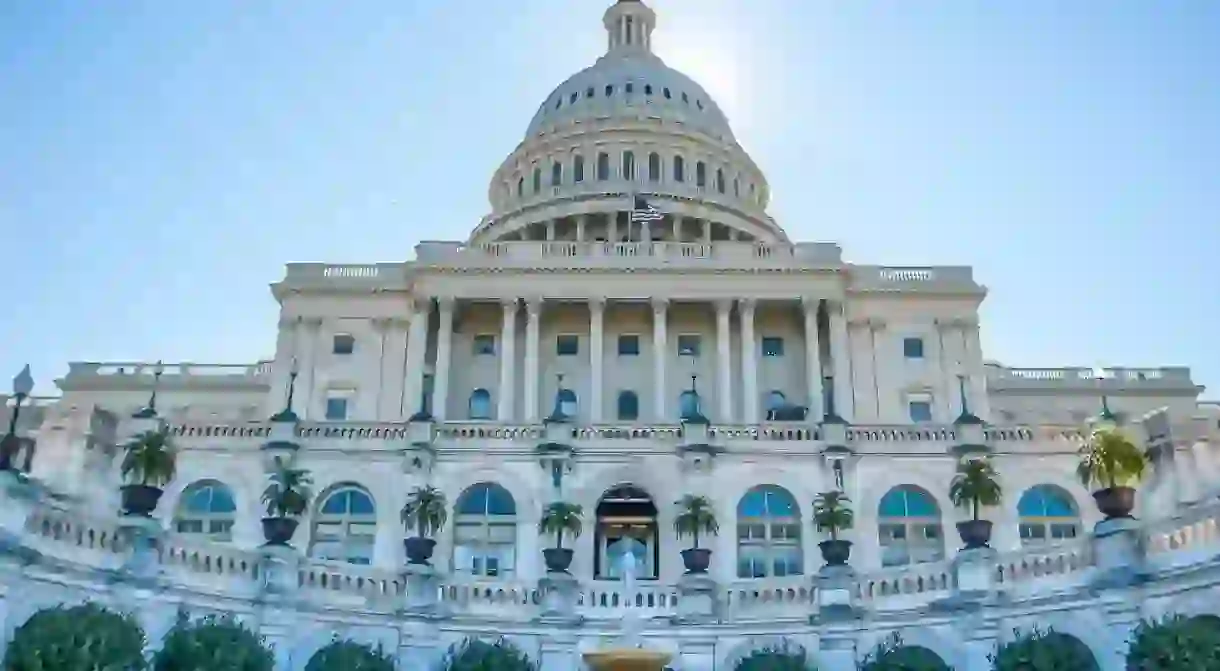A Brief History of the U.S. Capitol Building

The United States Capitol is one of the most symbolically important buildings in the country, standing “as a monument to the American people and their government.” It has housed the chambers of the House of Representatives and the Senate for over two centuries and is the focal point of the Legislative Branch of the government.
The Capitol that we see today has been through many different construction phases; throughout its history, it has burned down and been rebuilt and has gone through several extensions and restorations. The Capitol Campus consists of six Congressional office buildings and three Library of Congress structures in total.

History
Construction of the Capitol began in 1793, with the initial cornerstone laid by President Washington on September 18, 1793, after holding a competition to determine the design of the building.
The north wing was the first section completed, and the first session of Congress took place there on November 17, 1800. In 1803, Benjamin Henry Latrobe resumed construction and completed the south wing and reconstructed the north wing. In 1813, the wings were completed and connected via a wooden passageway.
On August 24, 1814, British troops set fire to the building during the War of 1812; however, a sudden rainstorm prevented the total destruction of the building. When Latrobe returned to make repairs in 1815, he took the opportunity to change the interior design and introduced new materials (marble from the Potomac River).
When Latrobe resigned in 1817 due to increasing pressure and funding issues, the responsibility was turned over to Boston architect Charles Bulfinch, who then proceeded to finish the restoration of the north and south wings and make the chambers for the Supreme Court, the House, and the Senate ready for use by 1819. Landscaping and decoration were completed by 1826, along with updates to the central dome.
An impressive building even then, by 1850, the Capitol could not accommodate the growing number of senators and representatives from new states and required an extension. Philadelphia architect Thomas U. Walter supervised the construction of the extensions, ensuring their consistency with the architectural style of the existing building.
The House of Representatives met in its new chamber on December 16, 1857, and on January 4, 1859, the Senate met in its current chamber. During the Civil War, construction was halted, with the Capitol used as a military barracks, hospital, and bakery. In 1862, work on the entire building resumed.
The dome and the canopy fresco painting on the inside were completed to great fanfare by 1869. Over the next century, more additions and renovations took place, with the addition of the marble terraces on the sides, elevators, fireproofing (due to another fire in 1898), electric lighting, and air conditioning.

After 1970, electronic voting machines were added to the House chamber, and more modern amenities, including televisions, computer and communications facilities, and surveillance, bring it up to the present day.
The U.S. Capitol Visitor Center is the newest addition to the complex, built only in 2008. Located underneath the Capitol, it contains exhibits, orientation displays, theaters and other facilities to make the visitor’s experience more informative.
Architecture
The building is a great example of 19th-century neoclassical architecture, with designs inspired by Roman and Greek ideas. It combines function with aesthetic; even as extensions were added, architects maintained the harmony with existing portions of the building.
Taking care of the Capitol
The Architect of the Capitol is the federal agency responsible for the operations, maintenance, and preservation of the Capitol complex. The president appoints the head of the AOC office for a term of 10 years. Currently, Stephen T. Ayers holds that position.
Visiting
Guided tours of the Capitol are available with a reservation, but the Capitol Visitor Center is accessible to the public during open hours.
Whether you are a history buff or not, the Capitol is truly a must-see sight when in Washington, D.C.














